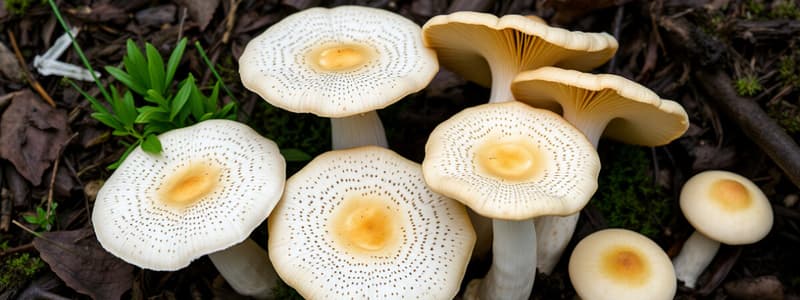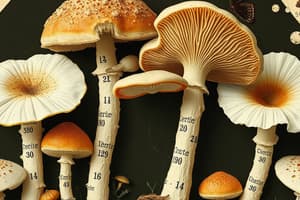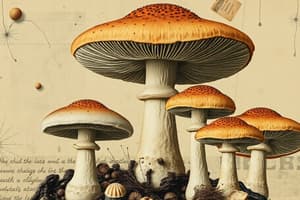Podcast
Questions and Answers
What is one characteristic that distinguishes fungal cells from plant cells?
What is one characteristic that distinguishes fungal cells from plant cells?
- Cell walls containing chitin (correct)
- Absence of mitochondria
- Presence of chloroplasts
- Lack of nuclei
What role do hyphae play in the structure of fungi?
What role do hyphae play in the structure of fungi?
- They are the reproductive structures of fungi
- They form a network known as mycelium (correct)
- They store nutrients for the fungus
- They facilitate photosynthesis for fungi
Which of the following statements is true about the classification of fungi?
Which of the following statements is true about the classification of fungi?
- Genetic analyses place fungi and animals in different supergroups
- Fungi are more closely related to humans than to plants (correct)
- Fungi are unicellular organisms only
- Fungi are classified in the same kingdom as plants
What is the primary form of a fungus that is typically visible above ground?
What is the primary form of a fungus that is typically visible above ground?
Which physical characteristic is common in fungi that may lead to their initial classification with plants?
Which physical characteristic is common in fungi that may lead to their initial classification with plants?
How do fungal cell walls differ from those of bacteria?
How do fungal cell walls differ from those of bacteria?
What is a mycelium in the context of fungi?
What is a mycelium in the context of fungi?
Why was the classification of fungi as part of the plant kingdom challenged?
Why was the classification of fungi as part of the plant kingdom challenged?
What feature of fungi is emphasized by the statement 'looks can be deceiving'?
What feature of fungi is emphasized by the statement 'looks can be deceiving'?
What describes filamentous fungi?
What describes filamentous fungi?
What is the primary product produced by the fungus Penicillium?
What is the primary product produced by the fungus Penicillium?
Which classification indicates a fungal group?
Which classification indicates a fungal group?
What happens during the sexual reproduction of fungi?
What happens during the sexual reproduction of fungi?
Which of the following fungi is known to have both sexual and asexual phases of reproduction?
Which of the following fungi is known to have both sexual and asexual phases of reproduction?
What is the role of zygomycota in their environment?
What is the role of zygomycota in their environment?
What characteristic do zygospores have that provides an advantage in harsh conditions?
What characteristic do zygospores have that provides an advantage in harsh conditions?
Which of the following fungi is classified as Ascomycetes?
Which of the following fungi is classified as Ascomycetes?
What is produced on the club-shaped structures of Basidiomycota fungi?
What is produced on the club-shaped structures of Basidiomycota fungi?
Which process allows fungi to produce a large quantity of genetically identical offspring quickly?
Which process allows fungi to produce a large quantity of genetically identical offspring quickly?
What primary structure do mushrooms represent for fungi?
What primary structure do mushrooms represent for fungi?
How do fungi contribute to food production?
How do fungi contribute to food production?
What is the primary function of spores in fungi?
What is the primary function of spores in fungi?
Which of the following is NOT a characteristic of yeasts?
Which of the following is NOT a characteristic of yeasts?
What is the role of saprobic fungi in the ecosystem?
What is the role of saprobic fungi in the ecosystem?
How do fungi primarily absorb nutrients?
How do fungi primarily absorb nutrients?
What type of relationship is exemplified by mycorrhizal fungi and plants?
What type of relationship is exemplified by mycorrhizal fungi and plants?
What feature distinguishes dimorphic fungi?
What feature distinguishes dimorphic fungi?
Which following fungi can be categorized as a pathogen causing disease in humans?
Which following fungi can be categorized as a pathogen causing disease in humans?
How do mushrooms primarily reproduce?
How do mushrooms primarily reproduce?
What do fungal spores typically consist of?
What do fungal spores typically consist of?
Match the following types of fungi with their characteristics:
Match the following types of fungi with their characteristics:
Match the following fungal structures with their functions:
Match the following fungal structures with their functions:
Match the following fungi with their primary uses or significance:
Match the following fungi with their primary uses or significance:
Match the following terms related to fungal reproduction:
Match the following terms related to fungal reproduction:
Match the following impacts of fungi on ecosystems:
Match the following impacts of fungi on ecosystems:
Match the following characteristics with their respective fungi:
Match the following characteristics with their respective fungi:
Match the following types of fungi with their characteristics:
Match the following types of fungi with their characteristics:
Match the following fungi products with their uses:
Match the following fungi products with their uses:
Match the following conditions affecting fungi:
Match the following conditions affecting fungi:
Match the fungal reproduction type with its description:
Match the fungal reproduction type with its description:
Match the following fungi with their common habitats:
Match the following fungi with their common habitats:
Match the fungal group with its unique features:
Match the fungal group with its unique features:
Match the following terms with their definitions:
Match the following terms with their definitions:
Match the following characteristics to their corresponding fungal groups:
Match the following characteristics to their corresponding fungal groups:
Match the following types of fungi with their descriptions:
Match the following types of fungi with their descriptions:
Match the following components of fungal cells with their characteristics:
Match the following components of fungal cells with their characteristics:
Match the following terms with their correct definitions:
Match the following terms with their correct definitions:
Match the following mushrooms with their typical growth conditions:
Match the following mushrooms with their typical growth conditions:
Match the following ecological roles of fungi with their functions:
Match the following ecological roles of fungi with their functions:
Match the following characteristics of fungi with their properties:
Match the following characteristics of fungi with their properties:
Match the following aspects of fungi with their related implications:
Match the following aspects of fungi with their related implications:
Study Notes
Defining Fungi
- Fungi are a unique group of organisms, diverse in form and complexity, ranging from unicellular yeasts to multicellular mushrooms.
- Historically misclassified as plants due to their growth patterns and non-motility, fungi are genetically more closely related to animals.
Classification and Characteristics
- Fungi belong to the same supergroup as Animalia, differentiating them from the Plantae kingdom based on modern genetic analysis.
- Fungal cells contain chitin in their cell walls, unlike plants which have cellulose.
Morphology of Fungi
- Mushrooms represent the fruiting body of fungi, while the majority of a fungus resides underground as a network of filaments known as hyphae.
- Hyphae are thin, one-cell-thick structures that form a mycelium, capable of extensive growth over vast areas.
Reproductive Structures
- Fruiting bodies like mushrooms are adapted for reproduction, producing spores instead of seeds, which are often microscopic and have protective shells.
- Spores can be dispersed by air or animals, enabling colonization of new environments.
Types of Fungi
- Yeasts are unicellular fungi, commonly associated with fermenting substances for food and beverages, such as Saccharomyces cerevisiae.
- Dimorphic fungi can switch forms between yeast and filamentous, which is significant for some pathogens like Candida albicans.
Ecological Role and Nutrition
- Fungi are chemoheterotrophs, requiring organic matter for growth; many serve as decomposers, recycling dead material in ecosystems.
- Less than 10% of fungi can colonize living plants, and only about 300 species can cause diseases in humans.
Mutualistic Relationships
- Mycorrhizal symbiosis involves fungi and plant roots, where both organisms benefit through nutrient exchange, which is crucial for plant health and land colonization.
Method of Growth and Nutrition Acquisition
- Fungi grow into their food by secreting enzymes to break down organic matter, absorbing nutrients directly instead of relying on a digestive tract like animals.
Human Utilization of Fungi
- Penicillium, known for penicillin production, revolutionized healthcare by providing an effective treatment for bacterial infections.
- Fungi play a significant role in food production, aiding in fermentation processes for items like bread, cheese, and soy sauce.
Research Applications
- Fungi serve as model organisms in scientific research to study cell growth, division, and genetics, proving invaluable in various biological fields.
Major Fungal Groups
- Zygomycota primarily consist of saprobes that can be found on decaying matter; they produce zygospores through sexual reproduction.
- Ascomycetes exhibit diverse lifestyles, often reproducing asexually but also capable of forming fruiting bodies like the well-known brewer's yeast.
- Basidiomycota include many mushroom-producing fungi, primarily decomposers, with their reproduction being mainly sexual through club-shaped spores formed under mushroom caps.
Defining Fungi
- Fungi are a unique group of organisms, diverse in form and complexity, ranging from unicellular yeasts to multicellular mushrooms.
- Historically misclassified as plants due to their growth patterns and non-motility, fungi are genetically more closely related to animals.
Classification and Characteristics
- Fungi belong to the same supergroup as Animalia, differentiating them from the Plantae kingdom based on modern genetic analysis.
- Fungal cells contain chitin in their cell walls, unlike plants which have cellulose.
Morphology of Fungi
- Mushrooms represent the fruiting body of fungi, while the majority of a fungus resides underground as a network of filaments known as hyphae.
- Hyphae are thin, one-cell-thick structures that form a mycelium, capable of extensive growth over vast areas.
Reproductive Structures
- Fruiting bodies like mushrooms are adapted for reproduction, producing spores instead of seeds, which are often microscopic and have protective shells.
- Spores can be dispersed by air or animals, enabling colonization of new environments.
Types of Fungi
- Yeasts are unicellular fungi, commonly associated with fermenting substances for food and beverages, such as Saccharomyces cerevisiae.
- Dimorphic fungi can switch forms between yeast and filamentous, which is significant for some pathogens like Candida albicans.
Ecological Role and Nutrition
- Fungi are chemoheterotrophs, requiring organic matter for growth; many serve as decomposers, recycling dead material in ecosystems.
- Less than 10% of fungi can colonize living plants, and only about 300 species can cause diseases in humans.
Mutualistic Relationships
- Mycorrhizal symbiosis involves fungi and plant roots, where both organisms benefit through nutrient exchange, which is crucial for plant health and land colonization.
Method of Growth and Nutrition Acquisition
- Fungi grow into their food by secreting enzymes to break down organic matter, absorbing nutrients directly instead of relying on a digestive tract like animals.
Human Utilization of Fungi
- Penicillium, known for penicillin production, revolutionized healthcare by providing an effective treatment for bacterial infections.
- Fungi play a significant role in food production, aiding in fermentation processes for items like bread, cheese, and soy sauce.
Research Applications
- Fungi serve as model organisms in scientific research to study cell growth, division, and genetics, proving invaluable in various biological fields.
Major Fungal Groups
- Zygomycota primarily consist of saprobes that can be found on decaying matter; they produce zygospores through sexual reproduction.
- Ascomycetes exhibit diverse lifestyles, often reproducing asexually but also capable of forming fruiting bodies like the well-known brewer's yeast.
- Basidiomycota include many mushroom-producing fungi, primarily decomposers, with their reproduction being mainly sexual through club-shaped spores formed under mushroom caps.
Studying That Suits You
Use AI to generate personalized quizzes and flashcards to suit your learning preferences.
Description
Explore the fascinating world of fungi and their distinct characteristics that have puzzled scientists and naturalists alike. From unicellular yeast to complex mushrooms, this quiz delves into the diverse morphology and classification of fungi, highlighting their unique traits separate from plants. Test your knowledge on what sets fungi apart in the natural kingdom.




